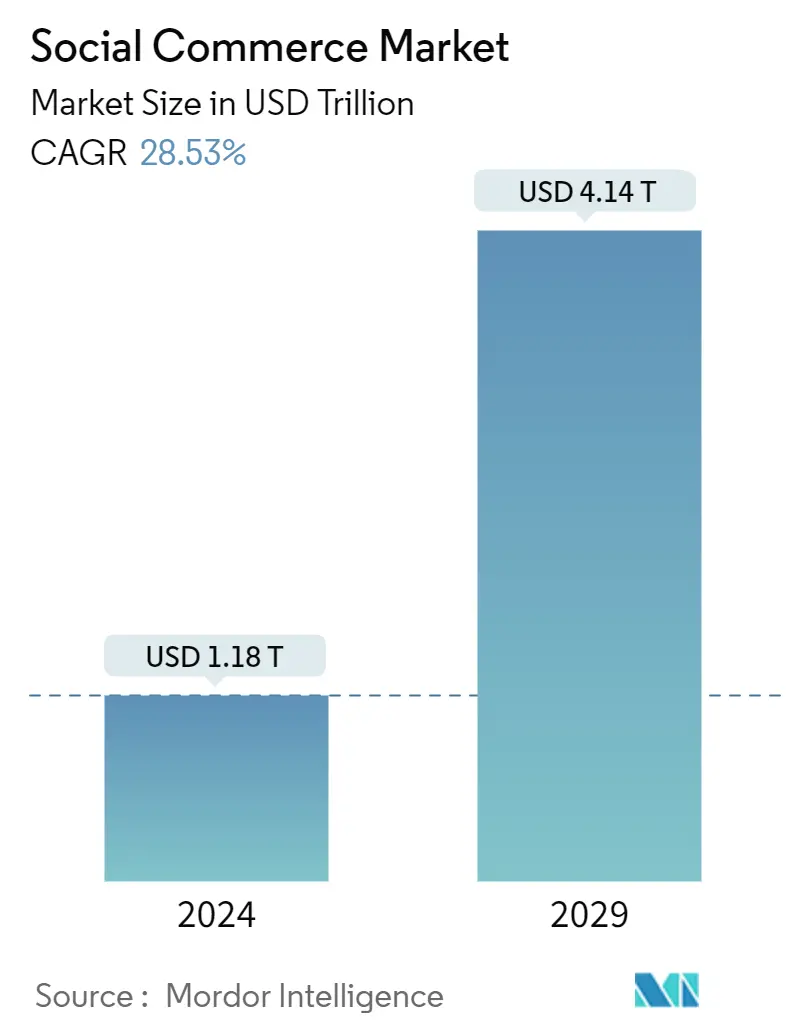Market Size of Social Commerce Industry

| Study Period | 2020-2029 |
| Market Size (2024) | USD 1.18 Trillion |
| Market Size (2029) | USD 4.14 Trillion |
| CAGR (2024 - 2029) | 28.53 % |
| Fastest Growing Market | North America and Europe |
| Largest Market | Asia Pacific |
Major Players
*Disclaimer: Major Players sorted in no particular order |
Social Commerce Market Analysis
The Social Commerce Market size is estimated at USD 1.18 trillion in 2024, and is expected to reach USD 4.14 trillion by 2029, growing at a CAGR of 28.53% during the forecast period (2024-2029).
Social commerce aims to expedite purchasing by removing needless extra stages and enabling clients to shop and check out immediately via social media networks. The market is anticipated to grow due to the widespread adoption of easy product discovery, checkout, and shopping processes. During the forecast period, a rise in potential customers from various social media platforms, including Facebook, Instagram, Snapchat, and Pinterest, is anticipated to propel market growth.
Social commerce made the integration of content sharing, payment processing, messaging, and buying possible. High levels of impulse buying, particularly among Gen Z and millennials, combined with easy access to social media networking sites have generated enormous potential for many businesses and sellers to boost sales, which will draw in new clients. Additionally, social commerce allows brands and merchants to combine social media with e-commerce platforms, creating a big branding opportunity. This has improved brand exposure on social media and made it possible for consumers to remember the brand through consistently interesting material. Due to the new opportunities it has created for individuals and small enterprises, social commerce has grown to be a driver for democratization. Consumers are more inclined to purchase from small businesses than from e-commerce websites when using social commerce.
Social Commerce Industry Segmentation
A quickly expanding subset of e-commerce known as "social commerce" uses digital media and social networks to streamline transactions between companies and clients. The social commerce market is segmented by business model, product type, sales channel, and geography. By business model, the market is segmented into business-to-consumer (B2C), business-to-business (B2B), and consumer-to-consumer (C2C). By product type, the market is segmented into personal and beauty care, apparel, accessories, home products, health supplements, food and beverages, and other product types (toys, DIY, electronics, and furniture). The market is segmented by sales channel into video commerce, social network-led commerce, social reselling, group buying, and product review platforms. The market is segmented by geography into North America, Asia-Pacific, Europe, South America, and the Middle East & Africa. The report offers the market size for the social commerce market in value terms in USD for all the abovementioned segments.
| By Business Model | |
| Business to Consumer (B2C) | |
| Business to Business (B2B) | |
| Consumer to Consumer (C2C) |
| By Product Type | |
| Personal and Beauty Care | |
| Apparel | |
| Accessories | |
| Home Products | |
| Health Supplements | |
| Food and Beverages | |
| Other Product Types |
| By Sales Channel | |
| Video Commerce | |
| Social Network-Led Commerce | |
| Social Reselling | |
| Group Buying | |
| Product Review Platforms |
| By Geography | |||||||||
| |||||||||
| |||||||||
| |||||||||
| |||||||||
|
Social Commerce Market Size Summary
The social commerce market is poised for significant growth, driven by the integration of social media and e-commerce platforms, which facilitates seamless shopping experiences for consumers. This market is characterized by the ability to streamline purchasing processes by eliminating unnecessary steps, allowing users to discover products, make purchases, and check out directly through social media networks. The increasing popularity of social media platforms such as Facebook, Instagram, Snapchat, and Pinterest is expected to contribute to the market's expansion. The trend is particularly pronounced among younger demographics, including Gen Z and millennials, who are more inclined to engage in impulse buying due to easy access to these platforms. This has created substantial opportunities for businesses to enhance sales and attract new customers, while also offering brands a chance to increase their visibility and engagement through consistent and engaging content.
The business-to-consumer (B2C) segment is a dominant force in the social commerce market, benefiting from a large customer base and the ability to foster direct relationships with consumers. Social media platforms have become essential tools for businesses to promote their brands and drive sales, with platforms like TikTok, Pinterest, and YouTube boasting millions of active users. The Asia-Pacific region, particularly China, is experiencing rapid growth due to factors such as increased disposable income, a large youth population, and improved connectivity. Major technology companies in China have successfully engaged a significant portion of the population through their social media platforms. The competitive landscape of the social commerce market is marked by efforts to strengthen retail and distribution networks, with leading companies investing in research and development to maintain their competitive edge. Recent partnerships, such as those between Amazon and Meta, as well as Amazon and Pinterest, highlight the ongoing efforts to integrate e-commerce with social media, offering consumers a more seamless shopping experience.
Social Commerce Market Size - Table of Contents
-
1. MARKET DYNAMICS AND INSIGHTS
-
1.1 Market Overview
-
1.2 Market Drivers
-
1.2.1 Growing Number of Social Media Platforms
-
1.2.2 Shift in Consumer Preferences Toward Online Purchase
-
-
1.3 Market Restraints
-
1.3.1 Privacy Concerns Over Gathering and Using Personal Data
-
1.3.2 Intense Competition in the Social Commerce Space
-
-
1.4 Market Opportunities
-
1.4.1 Emergence of Big Data Analytics and AI in Social Commerce
-
1.4.2 Collaboration with Influencers to Reach Niche Markets
-
-
1.5 Value Chain Analysis
-
1.6 Industry Attractiveness: Porter's Five Forces Analysis
-
1.6.1 Threat of New Entrants
-
1.6.2 Bargaining Power of Buyers
-
1.6.3 Bargaining Power of Suppliers
-
1.6.4 Threat of Substitutes
-
1.6.5 Intensity of Competitive Rivalry
-
-
1.7 Insights into Technological Advancements in the Industry
-
1.8 Impact of COVID-19 on the Market
-
-
2. MARKET SEGMENTATION
-
2.1 By Business Model
-
2.1.1 Business to Consumer (B2C)
-
2.1.2 Business to Business (B2B)
-
2.1.3 Consumer to Consumer (C2C)
-
-
2.2 By Product Type
-
2.2.1 Personal and Beauty Care
-
2.2.2 Apparel
-
2.2.3 Accessories
-
2.2.4 Home Products
-
2.2.5 Health Supplements
-
2.2.6 Food and Beverages
-
2.2.7 Other Product Types
-
-
2.3 By Sales Channel
-
2.3.1 Video Commerce
-
2.3.2 Social Network-Led Commerce
-
2.3.3 Social Reselling
-
2.3.4 Group Buying
-
2.3.5 Product Review Platforms
-
-
2.4 By Geography
-
2.4.1 North America
-
2.4.1.1 United States
-
2.4.1.2 Canada
-
2.4.1.3 Mexico
-
2.4.1.4 Rest of North America
-
-
2.4.2 Europe
-
2.4.2.1 United Kingdom
-
2.4.2.2 Germany
-
2.4.2.3 France
-
2.4.2.4 Russia
-
2.4.2.5 Italy
-
2.4.2.6 Spain
-
2.4.2.7 Rest of Europe
-
-
2.4.3 Asia-Pacific
-
2.4.3.1 India
-
2.4.3.2 China
-
2.4.3.3 Japan
-
2.4.3.4 Australia
-
2.4.3.5 Rest of Asia-Pacific
-
-
2.4.4 South America
-
2.4.4.1 Brazil
-
2.4.4.2 Argentina
-
2.4.4.3 Rest of South America
-
-
2.4.5 Middle East &Africa
-
2.4.5.1 United Arab Emirates
-
2.4.5.2 South Africa
-
2.4.5.3 Rest of Middle East & Africa
-
-
-
Social Commerce Market Size FAQs
How big is the Social Commerce Market?
The Social Commerce Market size is expected to reach USD 1.18 trillion in 2024 and grow at a CAGR of 28.53% to reach USD 4.14 trillion by 2029.
What is the current Social Commerce Market size?
In 2024, the Social Commerce Market size is expected to reach USD 1.18 trillion.

